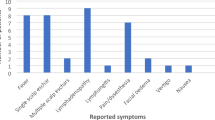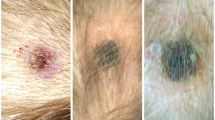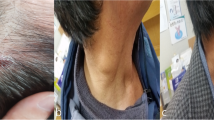Abstract
The clinical and epidemiological features of 56 patients with scalp eschar associated with neck lymphadenopathy after a tick bite (SENLAT) syndrome were evaluated at the National French Rickettsial Center. Eschar swabs, crusts, and biopsies as well as ticks and blood samples were acquired for molecular and serological assays. SENLAT predominantly affects children (p < 0.05), followed by 40- to 70-year-olds, and it is found mostly in women (p < 0.05). The seasonal distribution has two peaks: one in the spring (55%) and one in the autumn (30%). The etiological agent was identified in 18 cases, which include Rickettsia slovaca in 13 cases with incidences of two co-infections with Rickettsia raoultii and one case caused by Rickettsia sibirica mongolitimonae. Other possible agents that were found in attached ticks were Candidatus R. rioja, Coxiella burnetii, and Borrelia burgdorferi. The tick vector was Dermacentor marginatus in almost all cases, with the exception of one case, in which Ixodes ricinus was identified as the vector. Our findings show that SENLAT is a clinical entity characterized as a local infection controlled by the immune system and is neither pathogen- nor vector-specific.





Similar content being viewed by others
References
Raoult D, Berbis P, Roux V, Xu W, Maurin M (1997) A new tick-transmitted disease due to Rickettsia slovaca. Lancet 350:112–113
Lakos A (1997) TIBOLA—a new tick-borne infection. Orv Hetil 138:3229–3232
Raoult D, Lakos A, Fenollar F, Beytout J, Brouqui P, Fournier PE (2002) Spotless rickettsiosis caused by Rickettsia slovaca and associated with Dermacentor ticks. Clin Infect Dis 34:1331–1336
Lakos A (2002) Tick-borne lymphadenopathy (TIBOLA). Wien Klin Wochenschr 114:648–654
Oteo JA, Ibarra V, Blanco JR, Martinez de Artola V, Marquez FJ, Portillo A, Raoult D, Anda P (2004) Dermacentor-borne necrosis erythema and lymphadenopathy: clinical and epidemiological features of a new tick-borne disease. Clin Microbiol Infect 10:327–331
Ibarra V, Oteo JA, Portillo A, Santibanez S, Blanco JR, Metola L, Eiros JM, Perez-Martinez L, Sanz M (2006) Rickettsia slovaca infection: DEBONEL/TIBOLA. Ann N Y Acad Sci 1078:206–214
Parola P, Rovery C, Rolain JM, Brouqui P, Davoust B, Raoult D (2009) Rickettsia slovaca and R. raoultii in tick-borne Rickettsioses. Emerg Infect Dis 15:1105–1108
Sekeyova Z, Subramanian G, Mediannikov O, Diaz MQ, Nyitray A, Blaskovicova H, Raoult D (2012) Evaluation of clinical specimens for Rickettsia, Bartonella, Borrelia, Coxiella, Anaplasma, Franciscella and Diplorickettsia positivity using serological and molecular biology methods. FEMS Immunol Med Microbiol 64:82–91
Switaj K, Chmielewski T, Borkowski P, Tylewska-Wierzbanowska S, Olszynska-Krowicka M (2012) Spotted fever rickettsiosis caused by Rickettsia raoultii—case report. Przegl Epidemiol 66:347–350
Cascio A, Torina A, Valenzise M, Blanda V, Camarda N, Bombaci S, Iaria C, De LF, Wasniewska M (2013) Scalp Escher and neck lymphadenopathy caused by Rickettsia massiliae. Emerg Infect Dis 19:836–837
Ibarra V, Santibanez S, Eiros JM, Portillo A, Oteo JA (2011) Rickettsia rioja as etiological agent of DEBONEL/TIBOLA: clinical and epidemiological features. 6th International Meeting on Rickettsiae and Rickettsial Diseases, 2011, abstract O005
Ramos JM, Jado I, Padilla S, Masià M, Anda P, Gutiérrez F (2013) Human infection with Rickettsia sibirica mongolitimonae, Spain, 2007−2011. Emerg Infect Dis 19:267
Angelakis E, Pulcini C, Waton J, Imbert P, Socolovschi C, Edouard S, Dellamonica P, Raoult D (2010) Scalp eschar and neck lymphadenopathy caused by Bartonella henselae after tick bite. Clin Infect Dis 50:549–551
Edouard S, Gonin K, Turc Y, Angelakis E, Socolovschi C, Raoult D (2011) Eschar and neck lymphadenopathy caused by Francisella tularensis after a tick bite: a case report. J Med Case Rep 5:108
La Scola B, Raoult D (1997) Laboratory diagnosis of rickettsioses: current approaches to diagnosis of old and new rickettsial diseases. J Clin Microbiol 35:2715–2727
Socolovschi C, Kernif T, Raoult D, Parola P (2012) Borrelia, Rickettsia, and Ehrlichia species in bat ticks, France, 2010. Emerg Infect Dis 18:1966–1975
Bechah Y, Socolovschi C, Raoult D (2011) Identification of rickettsial infections by using cutaneous swab specimens and PCR. Emerg Infect Dis 17:83–86
Angelakis E, Roux V, Raoult D, Rolain JM (2009) Real-time PCR strategy and detection of bacterial agents of lymphadenitis. Eur J Clin Microbiol Infect Dis 28:1363–1368
Parola P, Diatta G, Socolovschi C, Mediannikov O, Tall A, Bassene H, Trape JF, Raoult D (2011) Tick-borne relapsing fever borreliosis, rural senegal. Emerg Infect Dis 17:883–885
Socolovschi C, Reynaud P, Kernif T, Raoult D, Parola P (2012) Rickettsiae of spotted fever group, Borrelia valaisiana, and Coxiella burnetii in ticks on passerine birds and mammals from the Camargue in the south of France. Ticks Tick Borne Dis 3:355–360
Yssouf A, Flaudrops C, Drali R, Kernif T, Socolovschi C, Berenger JM, Raoult D, Parola P (2013) Matrix-assisted laser desorption ionization-time of flight mass spectrometry for rapid identification of tick vectors. J Clin Microbiol 51:522–528
Estrada-Pena A, Bouattour A, Camicas A (2014) Ticks of domestic animals in the Mediterranean Region: a guide to identification of species. University of Zaragoza, Zaragoza, Spain
Mangold AJ, Bargues MD, Mas-Coma S (1998) 18S rRNA gene sequences and phylogenetic relationships of European hard-tick species (Acari: Ixodidae). Parasitol Res 84:31–37
Maurin M, Pelloux I, Brion JP, Del Banõ JN, Picard A (2011) Human tularemia in France, 2006–2010. Clin Infect Dis 53:e133–e141
Chomel BB, Boulouis HJ, Maruyama S, Breitschwerdt EB (2006) Bartonella spp. in pets and effect on human health. Emerg Infect Dis 12:389
Raoult D (2007) From cat scratch disease to Bartonella henselae infection. Clin Infect Dis 45:1541–1542
Van Dam AP, Kuiper H, Vos K, Widjojokusumo A, de Jongh BM, Spanjaard L, Ramselaar AC, Kramer MD, Dankert J (1993) Different genospecies of Borrelia burgdorferi are associated with distinct clinical manifestations of Lyme borreliosis. Clin Infect Dis 17:708–717
García-García JC, Portillo A, Núñez MJ, Santibáñez S, Castro B, Oteo JA (2010) Case report: a patient from Argentina infected with Rickettsia massiliae. Am J Trop Med Hyg 82:691
Parola P, Socolovschi C, Jeanjean L, Bitam I, Fournier PE, Sotto A, Labauge P, Raoult D (2008) Warmer weather linked to tick attack and emergence of severe rickettsioses. PLoS Negl Trop Dis 2:e338
Vitale G, Mansueto S, Rolain JM, Raoult D (2006) Rickettsia massiliae human isolation. Emerg Infect Dis 12:174
Acknowledgements
We would like to thank Dr Duclos Casalongo for the photos.
Funding source
IHU Méditerranée Infection.
Transparency declaration
None to declare.
Conflict of interest
The authors declare that they have no conflict of interest.
Author information
Authors and Affiliations
Corresponding author
Rights and permissions
About this article
Cite this article
Dubourg, G., Socolovschi, C., Del Giudice, P. et al. Scalp eschar and neck lymphadenopathy after tick bite: an emerging syndrome with multiple causes. Eur J Clin Microbiol Infect Dis 33, 1449–1456 (2014). https://doi.org/10.1007/s10096-014-2090-2
Received:
Accepted:
Published:
Issue Date:
DOI: https://doi.org/10.1007/s10096-014-2090-2




